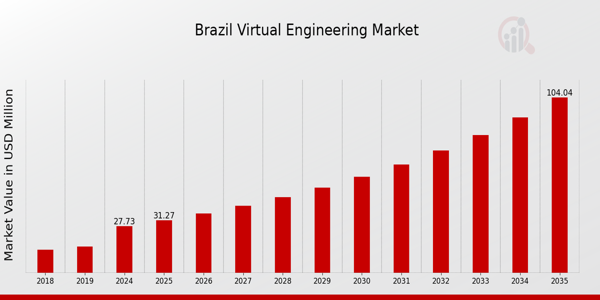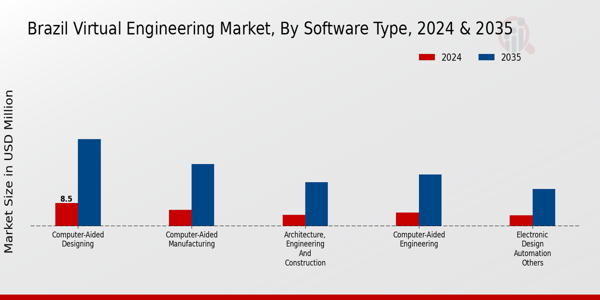Brazil Virtual Engineering Market Overview
As per MRFR analysis, the Brazil Virtual Engineering Market Size was estimated at 23.95 (USD Million) in 2023.The Brazil Virtual Engineering Market Industry is expected to grow from 27.73(USD Million) in 2024 to 104.03 (USD Million) by 2035. The Brazil Virtual Engineering Market CAGR (growth rate) is expected to be around 12.773% during the forecast period (2025 - 2035).
Key Brazil Virtual Engineering Market Trends Highlighted
The Brazil Virtual Engineering Market is undergoing significant trends as a result of the growing investment in digital infrastructure and the advancements in technology. The Brazilian government has been committed to promoting innovation through its initiatives, with a particular emphasis on the necessity of modernization in the engineering sector. This emphasis is demonstrated by a variety of policies that promote the utilization of virtual engineering tools, thereby improving the efficiency and collaboration of engineering firms.
The utilization of simulation and visualization technologies, which are essential components of virtual engineering, is increasing as industries throughout Brazil adopt Industry 4.0. Key market drivers include the growing demand for cost-effective solutions, which virtual engineering can offer. In order to remain competitive in a global market, Brazilian companies are striving to maximize their operations.
Virtual engineering enables them to develop more efficient processes without the significant investment required by traditional methods. The adoption of virtual tools has also been accelerated by the increasing prevalence of remote work as a result of the pandemic, which allows teams to collaborate seamlessly regardless of their location. Virtual engineering has the potential to enhance safety measures, reduce time-to-market, and improve project outcomes in sectors such as manufacturing, construction, and energy.
Opportunities in this market are plentiful. The market is further stimulated by the Brazilian agenda's emphasis on sustainability, as virtual engineering facilitates more sustainable practices by optimizing resource utilization and reducing waste. Recent trends suggest that an increasing number of Brazilian companies are investing in the training of their employees in virtual engineering skills, acknowledging its potential to stimulate innovation.
As Brazil invests in broadband infrastructure, the availability of high-quality digital services is expected to increase, thereby fostering an even more favorable environment for the growth of the virtual engineering market. Brazil is becoming a burgeoning center for virtual engineering solutions due to the convergence of government support, emergent technologies, and evolving work dynamics.

Brazil Virtual Engineering Market Drivers
Increasing Demand for Automation in Engineering Processes
The Brazil Virtual Engineering Market Industry is experiencing significant growth driven by the increasing demand for automation in engineering processes. In Brazil, the manufacturing sector is expected to integrate more automated systems, with the government’s initiative to enhance industrial productivity projected to boost the country's Manufacturing Value Added (MVA) by approximately 5% by 2025.
Major organizations such as Embraer are investing in virtual engineering to streamline their aircraft manufacturing processes, showcasing the operational efficiency gains that can be achieved through automation.By utilizing virtual engineering, Brazilian companies are capable of reducing production costs, speeding up project timelines, and ensuring higher accuracy in designs. This trend positions Brazil as a burgeoning hub for virtual engineering, greatly contributing to its market expansion. The push for Industry 4.0 and smart manufacturing systems further reinforces the relevance of virtual engineering technologies in Brazil, aligning with the nation's overall industrial strategy.
Government Support and Investment in Technology
The Brazilian government has been actively promoting technological advancements within the engineering sector through various support programs and funding initiatives. The National Program for the Development of Technological Base Companies (PIPE) provides financial assistance for innovation in manufacturing, which directly benefits the Brazil Virtual Engineering Market Industry.
Reports indicate that Brazil saw an increase of approximately 15% in funding for tech-based projects in 2022, fostering an environment of innovation and research.Established organizations like Instituto Nacional de Propriedade Industrial (INPI) have recognized the importance of patents in technological advancements, leading to a rise in intellectual property filings related to virtual engineering methods. This government-backed environment encourages more companies to adopt virtual engineering solutions, thereby stimulating market growth.
Surge in Renewable Energy Projects
Brazil's commitment to renewable energy, particularly wind and solar projects, is a substantial driver of growth in the Brazil Virtual Engineering Market Industry. The country ranked as one of the top nations in the world for renewable energy production, with a projection that 48% of its energy matrix will come from renewable sources by 2030. When combined with virtual engineering applications, Brazilian renewable energy projects can minimize costs regarding design optimization and execution.
Leading organizations, such as Eletrobras and Engie Brasil Energia, are increasingly leveraging virtual engineering for the planning and development of new energy facilities, which shows the significant benefits virtual technologies provide in managing complex renewable projects. This growing convergence of renewable energy investments and virtual engineering is expected to continue fueling market expansion.
Growth in Internet of Things (IoT) Integration
The integration of Internet of Things (IoT) technologies in engineering processes in Brazil is contributing to the growth of the Brazil Virtual Engineering Market Industry. IoT applications foster better connectivity and real-time data collection, which enhances project efficiency and decision-making. Current statistics indicate that the number of IoT devices in Brazil is anticipated to double by 2025, reaching over 1.6 billion devices.
Organizations such as WEG Industries are pioneering in integrating IoT with virtual engineering applications to improve operational performance in manufacturing facilities.The advancement in IoT technologies encourages Brazilian businesses to adopt virtual engineering solutions, creating a robust ecosystem for continuous innovation, thus significantly impacting the growth trajectory of the market.
Brazil Virtual Engineering Market Segment Insights
Virtual Engineering Market Software Type Insights
The Brazil Virtual Engineering Market, particularly within the Software Type segment, plays a vital role in driving innovation across various industries. As the nation continues to develop its technological infrastructure, the demand for sophisticated software solutions is on the rise. Key areas within this segment include Computer-Aided Designing (CAD), which streamlines the design process in fields such as automotive and aerospace; Computer-Aided Manufacturing (CAM), essential for optimizing production efficiency and accuracy; and Computer-Aided Engineering (CAE), which enhances product development through simulations and analyses.The Architecture, Engineering and Construction (AEC) sector has also leveraged virtual engineering tools to improve project delivery and collaboration.
Electronic Design Automation (EDA) is gaining significance as Brazil focuses on enhancing its electronics and semiconductor manufacturing capabilities, facilitating innovation in consumer electronics and telecommunications. Each of these areas contributes to the growing demand for integrated software platforms, with most solutions aimed at increasing productivity and reducing operational costs.Brazil's expanding technical workforce and emphasis on engineering education support these trends, fueling the growth of the Brazil Virtual Engineering Market. Moreover, government initiatives to promote digital transformation across industries provide ample opportunities for software providers to penetrate the market effectively.
The overall Brazil Virtual Engineering Market segmentation reflects a shifting landscape where technology becomes increasingly intertwined with business operations, underscoring the market's potential despite existing challenges related to regulations and initial investment costs.Each software type represents not just a tool but a pathway for Brazilian industries to embrace modernization and competitiveness on a global scale. Insightful market growth is expected as companies increasingly turn to these specialized software solutions to streamline operations, ensure compliance, and enhance product quality. In conclusion, as companies in Brazil adopt virtual engineering solutions across various sectors, the Software Type segment continues to develop robustly, reflecting both local industry needs and global technology trends.

Virtual Engineering Market Deployment Type Insights
The Brazil Virtual Engineering Market, particularly in terms of Deployment Type, consists of various methods that organizations can adopt to implement virtual engineering solutions. The On-premises deployment option is favored by enterprises that prioritize data security and control, offering them the ability to manage their infrastructure directly while customizing their solutions to fit specific operational needs.
This model has gained traction in sectors where regulatory compliance and data sovereignty are emphasized, such as manufacturing and finance.Conversely, the Cloud deployment option presents a more flexible and scalable alternative, enabling organizations to access advanced resources and technologies without the need for substantial upfront investments in physical infrastructure. This approach supports dynamic business models and accelerates innovation by allowing quicker updates and integrations with other cloud services.
In Brazil, the increasing digital transformation efforts, fueled by government initiatives promoting technology usage across industries, highlight the growing importance of both deployment methods within the market.As companies in Brazil look to enhance their engineering processes and optimize operational efficiencies, the balance between On-premises and Cloud solutions will play a crucial role in shaping the future landscape of the Brazil Virtual Engineering Market.
Virtual Engineering Market Organization Size Insights
The Brazil Virtual Engineering Market is characterized by distinct Organization Size segments, primarily encompassing Small and Medium Enterprises (SMEs) and Large Enterprises. SMEs have shown a significant inclination towards adopting virtual engineering solutions as they seek to enhance their operational efficiencies and reduce costs, driving innovation in product development and design. This trend is supported by government initiatives aimed at digitizing small businesses, thus providing them with necessary access to new technologies. On the other hand, Large Enterprises dominate the market due to their extensive resources and capacity to invest in advanced technologies to streamline operations and enhance collaboration across global teams.
These organizations leverage virtual engineering to conduct complex simulations and analyses, optimizing their Research and Development (R&D) processes vastly. The interplay between these segments reflects a growing demand for efficient engineering solutions, leading to an overall increase in the Brazil Virtual Engineering Market, fueled by rising investments in technology, the need for enhanced productivity, and the pursuit of competitive advantages across varied industries. This segmentation of the market highlights the diverse needs and strategic directions that organizations in Brazil are taking as they adapt to labor market demands and technological advancements.
Virtual Engineering Market Application Insights
The Application segment of the Brazil Virtual Engineering Market encompasses various critical areas, shaping the industry landscape significantly. Automation Design plays an essential role by enhancing efficiency and reducing human error in manufacturing processes, which is vital for Brazil's growing industrial sector. Plant Design utilizes advanced simulations to optimize layout and resource allocation, ensuring projects adhere to environmental regulations and sustainability goals, which are increasingly prioritized in Brazil due to government initiatives.Product Design focuses on innovation and the rapid prototype development of goods, aiding companies in meeting consumer demands effectively in a competitive market.
3D Modeling stands out as a crucial tool for visual communication, facilitating collaboration among stakeholders, and improving project accuracy, which is particularly beneficial in Brazil's diverse construction and engineering projects. Additionally, other applications in this segment foster advancements in technology adoption across various sectors, fueling the Brazil Virtual Engineering Market.As the industry progresses, these applications not only drive efficiency but also address the localized needs of Brazil's economy, presenting opportunities for growth and investment in this dynamic market.
Virtual Engineering Market Industry Vertical Insights
The Brazil Virtual Engineering Market is characterized by its diverse Industry Vertical segment, which plays a crucial role in shaping its growth trajectory. The Commercial Industry Vertical leverages virtual engineering technologies to enhance product design, streamline operations, and improve customer experiences, reflecting the thriving commercial landscape of Brazil with its vast consumer base and competitive dynamics. In contrast, the Defense Industry Vertical is instrumental in advancing national security through cutting-edge simulations and modeling, underscoring the importance of innovation in defense strategies.
This sector benefits from Brazil’s focus on bolstering its defense capabilities and modernization efforts. With the increasing application of virtual engineering solutions across various industries, these verticals are expected to witness significant contributions to the Brazil Virtual Engineering Market. The integration of emerging technologies, such as artificial intelligence and machine learning, further underscores the opportunities for growth, while also posing challenges related to data security and the adaptation of legacy systems. As companies in Brazil continue to embrace digital transformation, the segmentation within the Brazil Virtual Engineering Market’s Industry Vertical will be pivotal in driving innovation and efficiency.
Brazil Virtual Engineering Market Key Players and Competitive Insights
The Brazil Virtual Engineering Market is experiencing significant evolution and growth, catalyzed by advancements in technology and increased demand for innovative engineering solutions across multiple sectors. As industries leverage digital transformation to enhance their operations, the virtual engineering landscape has become highly competitive, with numerous players vying for market share. Companies in this domain offer a range of virtual engineering services that encompass simulations, modeling, and other tools aimed at improving efficiency and productivity in design processes. Understanding the competitive dynamics in this arena is crucial for stakeholders who seek to capitalize on emerging opportunities and navigate the complex marketplace.
PTC stands out as a formidable player in the Brazil Virtual Engineering Market, recognized for its robust product offerings and strategic initiatives tailored to the local landscape. With a specialized focus on product lifecycle management and augmented reality applications, PTC leverages its advanced technologies to enhance engineering capabilities within Brazilian industries. The company has built a strong brand presence through partnerships and localized solutions that address the unique demands of businesses in Brazil.
Notably, PTC's strengths lie in its commitment to continuous innovation and customer support, enabling clients to streamline their engineering processes and improve product development cycles. This focus on customer-centric solutions has positioned PTC as a leader in the Brazilian market, allowing it to effectively respond to the evolving needs of its clients.Hexagon, another key participant in the Brazil Virtual Engineering Market, has established itself with a diversified portfolio of products and services that cater to various engineering sectors.
Hexagon offers solutions in design, measurement, and process optimization, which are crucial for industries seeking to enhance their operational efficiency. The company benefits from a strong presence in Brazil, supported by a network of strategic partnerships and local collaborations that strengthen its market reach. Hexagon's ability to integrate various engineering processes through its software solutions sets it apart, allowing clients to experience improved workflows and data management. Furthermore, strategic mergers and acquisitions have bolstered Hexagon's capabilities in the region, enabling the company to expand its service offerings and adapt to the rapidly changing landscape of virtual engineering in Brazil.
Key Companies in the Brazil Virtual Engineering Market Include:
- PTC
- Hexagon
- Bentley Systems
- Siemens
- Autodesk
- Siemens Digital Industries Software
- SAP
- Altair Engineering
- Dassault Systemes
- IBM
- ANSYS
Brazil Virtual Engineering Market Industry Developments
In June 2025, Techint Engineering & Construction demonstrated a practical application of Hexagon's Smart 3D technology at the Hexagon Live 2025 event. This case study concentrated on the implementation of virtual 3D modeling in large-scale engineering projects, illustrating the substantial improvements in efficiency, quality, and innovation that occur in engineering workflows.
Hexagon's regional presence and dedication to the expansion of virtual engineering solutions in the Latin American market were fortified in April 2025 with the appointment of Danilo Carpino as its exclusive representative for Brazil.Voyansi, a Spanish company that specializes in BIM (Building Information Modeling) and Virtual Design & Construction (VDC), was acquired by Hexagon in June 2024.
This expansion of Hexagon's solution set in Brazil was particularly beneficial for digital construction and precise 3D modeling applications in the AECO (Architecture, Engineering, Construction, and Operations) sector.
Brazil Virtual Engineering Market Segmentation Insights
Virtual Engineering Market Software Type Outlook
-
- Computer-Aided Designing (CAD)
- Computer-Aided Manufacturing (CAM)
- Computer-Aided Engineering (CAE)
- Architecture, Engineering and Construction (AEC)
- Electronic Design Automation (EDA)Others
Virtual Engineering Market Deployment Type Outlook
Virtual Engineering Market Organization Size Outlook
Virtual Engineering Market Application Outlook
-
- Automation Design
- Plant Design
- Product Design
- 3D MODELLING
- Others
Virtual Engineering Market Industry Vertical Outlook
-
- Commercial Industry Vertical
- Defense Industry Vertical
| Report Attribute/Metric Source: |
Details |
| MARKET SIZE 2023 |
23.95(USD Million) |
| MARKET SIZE 2024 |
27.73(USD Million) |
| MARKET SIZE 2035 |
104.03(USD Million) |
| COMPOUND ANNUAL GROWTH RATE (CAGR) |
12.773% (2025 - 2035) |
| REPORT COVERAGE |
Revenue Forecast, Competitive Landscape, Growth Factors, and Trends |
| BASE YEAR |
2024 |
| MARKET FORECAST PERIOD |
2025 - 2035 |
| HISTORICAL DATA |
2019 - 2024 |
| MARKET FORECAST UNITS |
USD Million |
| KEY COMPANIES PROFILED |
PTC, Hexagon, Bentley Systems, Siemens, Autodesk, Tata Consultancy Services, Siemens Digital Industries Software, SAP, Emerson Electric, Altair Engineering, Dassault Systemes, IBM, ANSYS, Honeywell, Fujitsu |
| SEGMENTS COVERED |
Software Type, Deployment Type, Organization Size, Application, Industry Vertical |
| KEY MARKET OPPORTUNITIES |
Increased demand for digital twins, Growth in remote collaboration tools, Rising investments in smart manufacturing, Expansion of AR/VR applications, Adoption of AI in engineering processes |
| KEY MARKET DYNAMICS |
growing demand for automation, increasing investment in R&D, rising need for digital transformation, adoption of IoT technologies, skilled workforce availability |
| COUNTRIES COVERED |
Brazil |
Frequently Asked Questions (FAQ):
The Brazil Virtual Engineering Market is expected to be valued at 27.73 million USD in 2024.
By 2035, the Brazil Virtual Engineering Market is anticipated to reach a value of 104.03 million USD.
The expected compound annual growth rate (CAGR) for the Brazil Virtual Engineering Market from 2025 to 2035 is 12.773 percent.
Computer-Aided Designing (CAD) holds one of the largest market shares, valued at 8.5 million USD in 2024.
The market value for Computer-Aided Engineering (CAE) in 2035 is projected to be 19.12 million USD.
Major players in the Brazil Virtual Engineering Market include PTC, Siemens, Autodesk, and Bentley Systems.
The Computer-Aided Manufacturing (CAM) segment is valued at 6.0 million USD in 2024.
The growth of digital transformation initiatives presents significant opportunities for the Brazil Virtual Engineering Market.
Challenges in the Brazil Virtual Engineering Market include adapting to rapid technological advancements and industry demands.
The market value for Electronic Design Automation (EDA) is expected to reach 13.64 million USD by 2035.
















